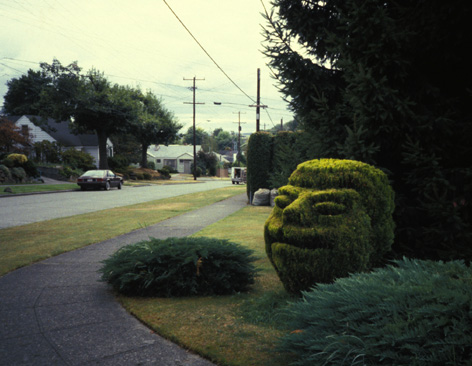
|
Garden styles and neighborly cooperation
|
| June has so many flowers that it's as close to excess as nature
achieves in the floristic realm. No other month has as many different
flowers. Throughout May, we were drenched by soaking rains which
exactly recalled rainforest conditions. It could be, if a high-pressure system
is extraordinarily late in settling it, that Seattle experiences another
"sunless summer." Already, we're about 9 inches above usual annual
rainfall. Outside of Alaska, no part of the U.S. receives fewer "heat units"
than northwest Washington. This, plus our lengthy periods of drizzle
and gray days, drives crazy some sun-starved visitors from the Southwest.
It even makes Seattleites testy at times. |
| Seattle is a good place to grow fungi, mosses and the like. But to
grow eggplant, okra, tomatoes and melons, it is one of the worst places.
Specific practical guidelines can enable you to succeed in the face of adversity.
Get the right plant varieties, plant them in the warmest sites, etc. But many
of us prefer to stick with what grows easily here. Indeed, some of us
carry this sentiment to its logical extreme, by just letting nature take its
course in our yards. The result, by and by, is a weedy, wild appearance,
usually with some trees booming to gargantuan size. |
| The other extreme is to maintain a formal, nitpicked garden, full
of gorgeous but fastidious plants. Grooming such display yards takes
many hours and can be wonderfully peaceful "mindless work." But few of
us can afford the time, or the money to hire-out such work. To the
vast majority of us, the only reasonable option is to plant and maintain
our yards in such passable fashion as we and our neighbors can
abide. Considerable latitude is available: some prefer color schemes, some
the clipped juniper style, here and there is the woodsy effect, or an
exuberant vegetable garden. Some of us have great patio gardens or
teeming houseplant collections. |
| Neighborly cooperation in gardening is one practical
"win-win" proposal that deserves a wider application. This at its simplest
level entails merely sharing surplus flowers, seeds, or produce. In other
cases one gung-ho gardener does some gardening for his or her neighbors
as well. This can happen when the thirst for more space and
gardening actively outruns the capacity of the owner's yard, and the
neighbors welcome green-thumbed volunteering. For example, I've planted
an acacia in my western neighbor's yard; in my eastern neighbor's yard
I planted flowers, garlic, fava beans, and a grape vine. To a neighbor
north of me went a crape myrtle I had no room for, to a neighbor south of
me a Chilean fire tree. |
Such work beautifies and diversifies the scenery, and builds ties. If
you don't know your neighbors, ahem, it might be sort of like asking
someone for a first date. You'll be nervous. But, nothing ventured, nothing
gained. If the answer is "no," you're no worse than you were.
|
(originally published in The Seattle Weekly, June 1996)
Back |
|
|

